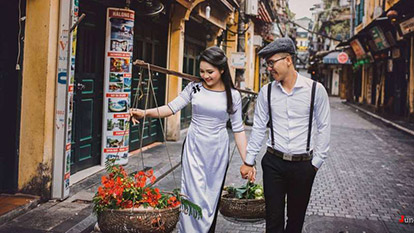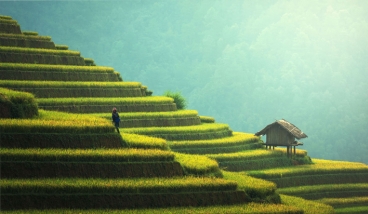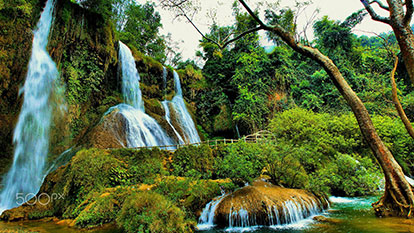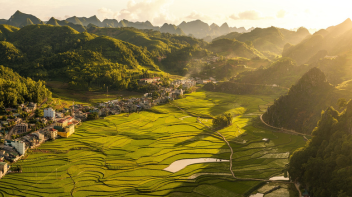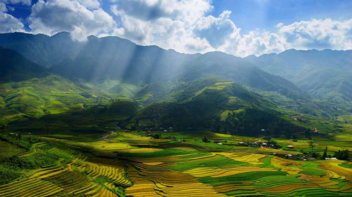Vietnam Geography & Climate
13/04/2019 1.718 Views
Vietnam is located in both a tropical and a temperate zone. It is characterized by strong monsoon influences, but has a considerable amount of sun, a high rate of rainfall, and high humidity.
Mainland Territory: 331,211.6 sq. km
Population: 84,115.8 thousand inhabitants (in 2006)
National Capital: Hanoi
Population: 84,115.8 thousand inhabitants (in 2006)
National Capital: Hanoi
- Vietnam is approximately 331,688 km² (128,066 sq mi) in area (not including Hoang Sa and Truong Sa islands), larger than Italy and almost the size of Germany. The perimeter of the country running along its international boundaries is 4,639 km (2,883 mi).
- The topography consists of hills and densely forested mountains, with level land covering no more than 20%. Mountains account for 40% of the area, with smaller hills accounting for 40% and tropical forests 42%. The northern part of the country consists mostly of highlands and the Red River Delta. Phan Xi Păng, located in Lào Cai province, is the highest mountain in Vietnam at 3,143 m (10,312 ft).
- The south is divided into coastal lowlands, Annamite Chain peaks, extensive forests, and poor soil. Comprising five relatively flat plateaus of basalt soil, the highlands account for 16% of the country's arable land and 22% of its total forested land.
- Topography of Vietnam.The delta of the Red River (also known as the Sông Hồng), a flat, triangular region of 15,000 km2 (5,792 sq mi),[27] is smaller but more intensely developed and more densely populated than the Mekong River Delta. Once an inlet of the Gulf of Tonkin, it has been filled in by the enormous alluvial deposits of the rivers over a period of millennia, and it advances one hundred meters into the Gulf annually. The Mekong delta, covering about 40,000 km2 (15,444 sq mi), is a low-level plain no more than three meters above sea level at any point and criss-crossed by a maze of canals and rivers. So much sediment is carried by the Mekong's various branches and tributaries that the delta advances sixty to eighty meters into the sea every year.
- Because of differences in latitude and the marked variety of topographical relief, the climate tends to vary considerably from place to place. During the winter or dry season, extending roughly from November to April, the monsoon winds usually blow from the northeast along the China coast and across the Gulf of Tonkin, picking up considerable moisture; consequently the winter season in most parts of the country is dry only by comparison with the rainy or summer season.
- The average annual temperature is generally higher in the plains than in the mountains and plateaus and in the south than in the north. Temperatures in the southern plains (Ho Chi Minh City and the Mekong Delta) varies less, going between 21 and 28 °C (70 and 82.5 °F) over the course of a year. The seasons in the mountains and plateaus and in the north are much more dramatic, and temperatures may vary from 5 °C (41 °F) in December and January to 37 °C (98.6 °F) in July and August.
Vietnam Climate
Vietnam is located in both a tropical and a temperate zone. It is characterized by strong monsoon influences, but has a considerable amount of sun, a high rate of rainfall, and high humidity. Regions located near the tropics and in the mountainous regions are endowed with a temperate climate.
The annual average temperature ranges from 22ºC to 27ºC. In Hanoi, the average temperature is 24ºC, in Ho Chi Minh City it is 27ºC, and in Hue it is 26ºC.
There are two distinguishable seasons. The cold season occurs from November to April and the hot season from May to October. The difference in temperature between the two seasons in southern Vietnam is almost unnoticeable, averaging 3ºC. The most noticeable variations are found in the northern provinces where differences of 12ºC have been observed. There are essentially four distinct seasons, which are most evident in the northern provinces.
Clothing:
North: In the highlands Nov-Mar, it is very cold, especially mornings. Jacket necessary.
South: T-shirts are enough all year around, except in the highlands, where it can be cooler. Apr-May is very hot. Hats are essential to avoid sun stroke.
Advice: Best season to travel in Vietnam: from November to May. vietnam travel
Vietnam is located in both a tropical and a temperate zone. It is characterized by strong monsoon influences, but has a considerable amount of sun, a high rate of rainfall, and high humidity. Regions located near the tropics and in the mountainous regions are endowed with a temperate climate.
The annual average temperature ranges from 22ºC to 27ºC. In Hanoi, the average temperature is 24ºC, in Ho Chi Minh City it is 27ºC, and in Hue it is 26ºC.
There are two distinguishable seasons. The cold season occurs from November to April and the hot season from May to October. The difference in temperature between the two seasons in southern Vietnam is almost unnoticeable, averaging 3ºC. The most noticeable variations are found in the northern provinces where differences of 12ºC have been observed. There are essentially four distinct seasons, which are most evident in the northern provinces.
Clothing:
North: In the highlands Nov-Mar, it is very cold, especially mornings. Jacket necessary.
South: T-shirts are enough all year around, except in the highlands, where it can be cooler. Apr-May is very hot. Hats are essential to avoid sun stroke.
Advice: Best season to travel in Vietnam: from November to May. vietnam travel
ONLY WITH US : 100 % MONEY BACK GUARANTEE within 10 days from the date of booking if not satisfied.
For further information, or simply a free quote, please contact us at any time via our email: info@galatourist.com, our experienced consultants will reply to you within 48 hours.Sincerely yours & see you soon!
GALATOURIST since 2005.
Related Articles
Coronavirus situation by traveller in Vietnam on February 4, 2020
Coronaviruses are a large family of viruses, which cause illnesses ranging from a simple cold (some seasonal viruses are coronaviruses) to more severe conditions such as MERS or SARS. The virus identified in Wuhan in December 2019 is a novel coronavirus. It was named 2019-nCoV.
Top 29 best places to visit in Hanoi Vietnam
As the capital of Vietnam, Hanoi still retains its leisurely pace in a quiet atmosphere compared to the more bustling Ho Chi Minh City. However, Hanoi deserves to be the capital of Vietnam thanks to its typical culture accumulated along the passage of time which defines best what Vietnam is. The article will show you 29 best places to visit in Hanoi for your choices.
Explore Hoang Su Phi rice terraced fields - Vietnam iconic landscape
Terraced rice fields are one of the breathtaking wonders shaped by both nature and human hands — a truly unique form of cultivation that can only be found in Vietnam. Among the most iconic landscapes, the Vietnam terraced rice fields in Hoang Su Phi are a top destination, especially during the stunning golden rice season. The Hoang Su Phi rice terraced fields, with their layered golden waves cascading down the mountains, attract thousands of local and international visitors each year. However, reaching and exploring these scenic rice terraces can be quite challenging for those who are inexperienced or unprepared. To help you make the most of your trip, we’ve compiled some practical travel tips for Hoang Su Phi that will guide you through a smooth, safe, and unforgettable adventure in one of Vietnam’s most breathtaking rural regions.
Pu Luong Travel Guide Vietnam A to Z
Surrounded by lush forests, rolling hills, and cascading rice terraces, Pu Luong Vietnam invites you to reconnect with what truly matters. Whether you're seeking quiet contemplation, exciting adventures, or meaningful moments with friends and family, this destination has something for everyone. Our Pu Luong travel guide below will provide you with all the essential information, tips, and inspiration to plan a memorable trip this week. From scenic hikes and refreshing streams to cultural encounters with ethnic minorities, Pu Luong offers a magical blend of serenity and exploration.
Foodtour in Chinatown Saigon
When mentioning Saigon Chinatown, people will immediately think of Chinatown in the 5th District, where many architectural works of Assembly Halls and pagodas with ancient Chinese architecture are concentrated, and especially, this is also the place where many traditional Chinese restaurants can make your taste buds explode. From famous dishes such as dimsum, roast duck, duck braised noodles to Chinese sweet soup, egg tarts, Chinatown Ho Chi Minh brings a complete experience for tourists who love to explore East Asian culture.
Best season to visit Ben Tre Vietnam
When is the best time to travel to Ben Tre? Learn about Ben Tre’s climate characteristics and choose the ideal time to discover the charm of its rivers, fruit gardens, and vibrant folk festivals. We hope the article below will help you plan your Ben Tre trip according to your schedule and personal preferences!
Travel guide to Ba Be National Park Vietnam in Bac Kan province
Ba Be National Park in Bac Kan stands out with its limestone mountains, the largest freshwater lake in Vietnam, diverse ecosystems, and distinctive ethnic cultures. From boating and trekking to exploring caves and traditional villages, it is an ideal destination for those who love nature and want to experience unique local culture.
What to do in Ba Be Lake ? Best things to do in Ba Be Bac Kan
If you're looking for an unspoiled ecotourism destination where forests, mountains, rivers, and authentic local culture come together, then Ba Be Lake, a true "green jewel" nestled in the heart of Vietnam’s northeastern mountains – is a must-visit. Located in Ba Be National Park, Bac Kan province, this is the largest natural freshwater lake in Vietnam, promising unforgettable travel experiences.
Complete travel guide for Ba Be Lake in Bac Kan
Ba Be Lake is one of the most famous tourist destinations in Northeast Vietnam. This place draws visitors with its cool climate and spectacular natural landscapes nestled in the mountains and forests of Bac Kan. What to do in Ba Be? When to visit Ba Be Lake? Follow Galatourist to discover all the practical tips from A to Z to make the most of your trip to Ba Be and create unforgettable memories!
Admire the majestic but charming beauty of Dai Yem Waterfall in Moc Chau
Located in the heart of Moc Chau, Vietnam, Dai Yem Waterfall is a must-visit for nature lovers and adventure seekers alike. Known for its breathtaking beauty and tranquil surroundings, this hidden gem is the perfect escape from the bustling city life. If you're wondering what to do in Moc Chau, Vietnam, a trip to Dai Yem Waterfall should be at the top of your list. In this article, we'll explore the best ways to experience this natural wonder and share tips for making the most of your visit. Stay tuned to the Vietnam travel blog by Galatourist for more insights!
Activities in Ha Giang Viet Nam: Meo Vac Town what to do
Meo Vac, located in Ha Giang, Vietnam, is a stunning location renowned for its imposing limestone cliffs, magnificent scenery, and diverse ethnic cultures. Meo Vac, which is tucked away in the untamed mountains of northern Vietnam, gives daring visitors the chance to take in the breathtaking scenery and the lively local way of life. Here are the suggestions for Meo Vac Town what to do.
Ha Giang 1 day tour: What to do for a day tour in Ha Giang Loop
Are you up for an exciting journey through the best-kept secret in Vietnam? When you come on our Ha Giang 1-Day Tour in Ha Giang Loop, you can expect to be astounded by the stunning scenery and fascinating cultural experiences that lie ahead of you.
Testimonials
The following are the real customer reviews about GalaTourist by video clips, email & feedback form, etc... please check it out!

Ms. Francesca Tronconi & Mr Vizzolini Davide (2pax) from Spain
Ms. Francesca Tronconi & Mr Vizzolini Davide from Spain, taked a Tour in Vietnam on 8.2018

Mrs & Mr. DUPUIS (2pax) from United States
Mrs & Mr. DUPUIS from US taked a vacation of THAILAND & CAMBODIA & VIETNAM 14 days on 3.2018

Mr. Jeffrey Szymanski (2pax) from United States
They taked a trip of Vietnam and Cambodia 11 days on 3.2018

Mrs Rosemary McGuinness (2pax) from Australia
Taking a trip of Vietnam & Cambodia 14 days on 26th mars 2018

Mrs Elena Maria Sanchez (2pax) from Spain
Mrs Elena Maria Sanchez from Spain taked a trip in Vietnam on 1.2016

Group Marissa (4pax) from United States
Group Marissa 4pax from USA taked a Trip in Vietnam on 2.2016

Mr Jerzy (2pax) from Canada
Mr Jerzy from Canada have traveled in Vietnam on 3.2016

Mr Ricardo Velasco (8pax) from Argentina
Sr Ricardo Velasco 8pax - Argentina taked a trip to Vietnam Cambodia Thailand on 2016.





